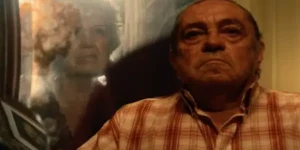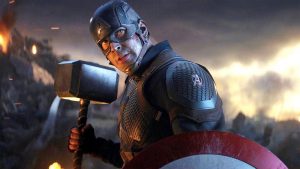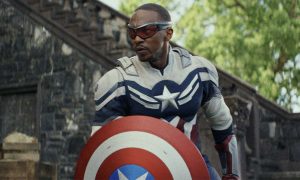
Deep within the wilderness of Tibet, a warlord called Ying Ko dominates the villagers and consolidates all power for himself. But one day, Ying Ko is captured by a holy man and taken to a mystical temple. The holy man dazzles Ying Ko with displays of magic, none more chilling than when he refers to the warlord, a white American, by his true name: Lamont Cranston.
For all the strange choices that director Russell Mulcahy and writer David Koepp make for their 1994 film The Shadow, the titular hero’s origin might be the best. After all, Koepp created this backstory for the Shadow’s all by himself, a bold move when bringing to life a character who has been around for 60 years. Imagine if Superman: The Movie began with Clark Kent getting dosed with wonder drugs instead of fleeing Krypton, or if 1989’s Batman said that Bruce Wayne’s parents raised him to strike fear in the hearts of men. Yet Koepp’s backstory revision gave The Shadow a clear backbone on which to build the rest of the movie, teaching later filmmakers a forgotten lesson they should learn to follow again.
Who Knows The Origin of The Shadow?
The true origin of the Shadow is much more complicated than even the Orientalist vision provided by Koepp and Mulcahy. The Shadow began life in 1930 as a narrator, a pitchman that publishers Street & Smith designed as the host for their radio show, Detective Story Hour. In each episode of the Detective Story Hour, the Shadow introduced listeners to a dramatized version of a tale previously published in Detective Story Magazine.
The show boosted sales for Street & Smith, but also garnered attention for stories about the Shadow himself. So the publisher went straight to work, enlisting Walter B. Gibson to write Shadow pulp novels under the pen name Maxwell Grant. Hundreds of Shadow novels and stories have been published over the years, most recently by hit author James Patterson and his associates.
In 1937, the Shadow became the main character of his own radio show where initially a young Orson Welles performed the character. The radio show ran until 1957, much longer than the Shadow comic strip, which only lasted from 1940 to 1942. After appearing in a series of short films in 1931 and 1932, the Shadow starred in multiple serials released between 1937 and 1946, as well as a 1958 television pilot called Invisible Avenger.
In 1964, the Shadow moved to his new regular home, the world of comic books. Shadow comics have been produced fairly regularly since then by publishers such as Archie Comics, both DC and Marvel, and most recently Dynamite Comics.
Who Is the Shadow?
Like any other character who has jumped across media and reboots, the Shadow has a few different backstories. According to the most common origin, the Shadow is really Lamont Cranston, a rich playboy who fights crime as a dark avenger of the night (why, yes, Bill Finger did borrow from the Shadow when developing Batman). But before that, the Shadow was World War I pilot Kent Allard, who battles baddies after learning magic techniques from a hidden tribe.
So Cranston must just be a new secret identity that writers made for a Shadow reboot, right? No, at least not at first. Instead Lamont Cranston was a rich guy who looked a lot like Allard. After the Shadow saved Cranston’s life, Allard borrows Cranston’s identity to further his own ends. In other words, Kent Allard pretends to be Lamont Cranston who pretends to be the Shadow.
Confused? Well, it gets weirder. Sometimes, Allard takes the identity of businessman Henry Arnaud, another separate person that the Shadow rescued and happens to look like him. Sometimes, he’s a janitor called Fritz. Sometimes, he’s a criminologist called George Clarendon. To the surprise of no one, most of these extra identities and backstories get ignored, going for the simpler explanation in which the Shadow is Cranston and that’s all. But, also to the surprise of no one, writers occasionally try to incorporate all of the previous story elements in one way or another, including Garth Ennis’s recent run for Dynamite.
Unclouding Men’s Minds
Although some earlier Shadow stories had Allard use the alias Ying Ko, none featured the origin that Koepp made for the 1994 film. Koepp’s backstory for the movie doesn’t just streamline the overly convoluted nature of the character. As he explained to MovieMaker Magazine back in 1994, Koepp sought to distinguish his movie from Batman by focusing on guilt instead of revenge.
The writer found his hook in the famous tagline from the radio show and the piercing question: “Who knows what evil lurks in the hearts of men?” The Shadow knows, according to Koepp, because “he was uncomfortably familiar with the evil in his own heart.” By making the Shadow a former warlord who did horrible things and now wants to improve the world with the techniques he used, Koepp’s story became one “of guilt and atonement.”
Koepp is hardly the only writer to change up superheroes for their big screen adaptations. Sam Raimi didn’t want to waste time explaining how a broke teen like Peter Parker could invent web-hooters, so he made his webbing organic for Spider-Man. More recently, directors Anna Boden and Ryan Fleck, along with a group of co-writers, changed the insanely twisty history of Carol Danvers to streamline it for Captain Marvel.
But every time someone makes these changes, some superfans complain, insisting that creators respect the comics. That’s why we’ve got Tom Holland’s Peter Parker making web-shooters and Wolverine back in yellow spandex.
To be sure, there’s something thrilling about seeing comic panels make it to the big screen, even this far into the superhero boom. But those reproductions only matter to the degree that the movies tell good stories with compelling themes around them (see: Zack Snyder’s Watchmen). If superhero movies get too caught up in copying the comics to please literalist fans, then the stories suffer. They’ve failed to transfer the essence of why the character works to the advantages and limitations of the medium of film.
The Shadow isn’t a great movie. But it didn’t falter because of a convoluted backstory or lack of thematic relevance. Who knows what high expectations lurk in the hearts of fans? The Shadow knows, and modern superhero moviemakers should know it too.
The post The Shadow Savaged Its Comic Book Lore and That’s a Good Thing appeared first on Den of Geek.








